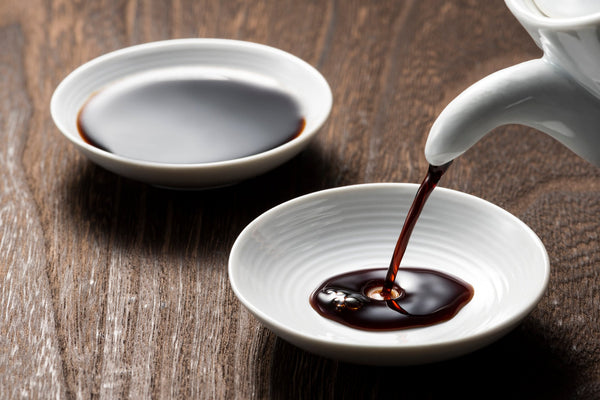Only A Gluten-Free Alternative? Everything You Need to Know About Tamari Sauce

Jump to:
If you’re familiar with tamari, then the first thing that may come to mind about it is gluten-free soy sauce. In the West, Tamari Shoyu tends to be perceived as such, but it is actually thought of as something completely different in Japanese cuisine. What is Tamari Shoyu? Why has it gained its unique reputation in the West? What is the difference between Tamari and Soy Sauce? We’ll answer all of these questions and more, as we dive deeper into the topic of Tamari Shoyu in this article.
What Is Tamari?

According to the official Japanese Soy Sauce Information Center, tamari is one of the six main kinds of soy sauce (referred to as shoyu) found in Japanese cuisine. Produced mainly in the Chubu region in Central Japan, tamari is thicker than the more common koikuchi shoyu (dark soy sauce), has a denser flavor and deeper color, and is often the go-to shoyu when making glazes or sauces like teriyaki. When heated, tamari reveals a tinted red color that makes grilled or boiled dishes look more appealing. It is also often used as an ingredient in senbei rice crackers for this exact reason.
What Is The Difference Between Tamari And Soy Sauce?

One thing that sets tamari apart from standard shoyu is that tamari was not meant to be a direct competitor with shoyu. Instead, tamari is intended to be its own kind of shoyu. Yes, tamari is in fact a type of soy sauce, but its origin is actually based on being a by-product of miso. In fact, the remaining liquid that is made as a process of making miso became known as tamari – this means that its ingredients are slightly different from the shoyu you might be familiar with.
The biggest difference between tamari and shoyu is the fact that tamari (for the most part) is free of wheat. This is because, again, that tamari is a by-product of miso, and miso does not contain wheat. Another difference is that tamari is usually lower in salt compared to traditional soy sauce. This means that tamari shoyu could be a great gluten-free or lower-sodium alternative to the standard shoyu.
How Is Tamari Made?
As previously mentioned, tamari is a by-product of miso. The liquid that seeps out of miso (in this case, known as moromi), is what is turned into tamari. This leftover liquid is taken and fermented in a different vat, like a wooden barrel for example, and is left to further ferment for several months to several years before being packaged and sold to consumers.
Since the amount of liquid produced during the production of miso is not much, (if we look at the amount of miso being produced vs the amount of tamari being produced) traditionally making tamari requires a lot of time and raw materials. These days, the amount of tamari makers who stick to making it the traditional way is quite scarce because it requires a lot of time and skill.
What Does Tamari Taste Like?

Tamari has its own unique flavor which tastes different from shoyu. This is due to the differences in ingredients and production of tamari. Tamari actually has a richer and denser flavor than shoyu, but it is less salty at the same time. This may be because tamari contains a higher amount of soybeans and less water compared to conventional soy sauce.
Among all of the shoyu, tamari shoyu is said to pair best with red meat dishes or sashimi. It is also said to be the best choice for when making teriyaki sauce. We will touch on this a bit later in this article, but tamari’s natural dark color is probably the reason for this sentiment. The fact that tamari is made with a higher percentage of soybeans than other shoyu can suggest that tamari also has its own savory and unique umami flavor, which is a flavor that cannot be found in other shoyu.
Is Tamari Gluten Free?
The answer is yes…but sometimes no. This really depends on the maker of the tamari. As previously mentioned, tamari is often marketed as a gluten-free alternative to soy sauce in the West. However, this notion does not really exist in Japan because tamari was not intended to be a gluten-free alternative to shoyu, it just kind of worked out that way.
Tamari makers add trace amounts of wheat into tamari for a number of reasons – to improve its taste, to give it a longer shelf life, etc. However, there ARE makers who make truly gluten-free tamari too. The bottom line is that you just need to check the label of the tamari you want to purchase, especially if you are gluten intolerant.
Is Tamari Healthier Than Soy Sauce?
Generally speaking, tamari is lower in sodium than soy sauce, meaning that it can be a good lower-sodium option, which many people may find to sound healthier. However, many tamari, especially tamari found in grocery stores contain additives like high-fructose corn syrup, alcohol, or preservatives. There is no yes or no answer when it comes to this question. Unfortunately, it will all depend on the maker or brand of the tamari and the methods used to make it.
How To Use Tamari?

Since tamari naturally has a thick consistency, it makes a great dipping sauce for sashimi and sushi. In fact, it is thought to have a supreme umami flavor among all six types of shoyu. It is also a great shoyu option to use in marinades and as a seasoning because of its ability to bring the flavor out of the ingredients it is being paired with. Tamari works specifically well in marinades because it is of course flavorful, but it can also cancel out any strong odors from meat or fish.
Its exceptionally dark color also works well for making thicker sauces like teriyaki because tamari not only provides rich flavor, but it also makes dishes look more visually appealing. For this reason, you will often see tamari featured as an ingredient in Japanese simmered dishes and even senbei rice crackers.
It is said that tamari also has excellent compatibility with foods of richer nature (think, steak and surprisingly red wine too.) The next time you are making a pasta sauce or meat dish with red wine, try adding in a splash of tamari and you might be surprised by the result!
Substitute For Tamari?
If you are not gluten-intolerant, then the obvious answer would be just to use an all-purpose shoyu, (like koikuchi shoyu or even usukuchi shoyu for example) instead. Depending on what you are making, you can also use ingredients like miso paste or fish sauce, as they are packed with salty and umami flavors. Worst case, you can also just use salt in place of tamari. If you have a soy allergy, then this soy-free soy sauce may also be a unique and helpful option!
Where To Buy Tamari?
Production of premium tamari shoyu is becoming especially rare in recent years, as explained earlier. Many tamari makers both in and outside of Japan opt to add additional ingredients and fillers into their tamari to speed up the fermentation process and give it a “better” flavor. However, many people may feel uncomfortable regularly using tamari in their foods knowing that they contain chemicals or additives.
Here at Japanese Taste, we are dedicated to only selling tamari made using traditional brewing methods with high-quality ingredients and no additives. Even in Japan, finding a true tamari shoyu that fits these criteria can be a challenge. If you’re looking for true and authentic tamari, then you can check here to see our collection from brands that we stand by.
Best Tamari Brands?
In this section, we’d like to talk about some tamari brands that still use traditional methods to make their tamari. These companies are also small and local to certain regions in Japan, meaning that they might not be as well known even among the Japanese community.
Minamigura

Minamigura is one of the few remaining tamari makers that produce completely additive-free tamari using 100% domestic ingredients, including salt! (Something increasingly rare for Japan.) They have found a way to make authentic tamari shoyu only using organic soybeans and salt that tastes delicious. Their tamari is aged in kioke wooden barrels for three years before being sold to consumers.
Minamigura is truly one of the only tamari makers keeping traditional tamari shoyu-making methods alive and is doing so by using 100% domestic and organic ingredients. Their tamari is a great option for someone who is looking for something truly gluten-free and organic, and that is also free of additives.
Tomizu

Another great tamari maker is Tomizu. Their tamari is made using a method called “tosui-shikomi,” where soybeans and barley koji (a fermenting agent) are mixed with 100% clear stream water. Only carefully selected raw materials of domestic soybeans, salt, and barley koji have been chosen to be included in this product, to ensure the best taste possible. It is another great and 100% authentic tamari option that is gluten-free and made from premium ingredients.
Ito Shoten

Itoh Shoten is also a great and historic Japanese tamari maker that has been producing fine tamari shoyu since the Edo period. In order to make their tamari, high-quality domestically produced soybeans, koji, and water are aged together in a cedar vat. The final product is a rich and gluten-free tamari shoyu that can be used for cooking or as a dipping sauce.
Which Shoyu Should You Choose?

At the end of the day, you should choose a shoyu based on your personal preferences. You should ask yourself; what kind of shoyu am I looking for exactly? (If you’re unsure about which shoyu to choose more, then check out this article to learn more about shoyu.)
Of course, those looking for a gluten-free alternative to shoyu should choose tamari shoyu (but be sure to cross-check and ensure that it doesn’t contain any wheat.)
Another reason to choose tamari shoyu over other shoyu is if you are looking for something that works well in marinades, sauces, and glazes, yet pairs well with red meat-based dishes and sashimi at the same time. Tamari shoyu is a well-rounded shoyu option and it can be used in a variety of dishes. As long as you know how to use it, then it can end up becoming one of the pantry staples that you go for most often.
Have you tried tamari shoyu before? What did you think about it? Let us know your thoughts about tamari in the comments below.

0 comments